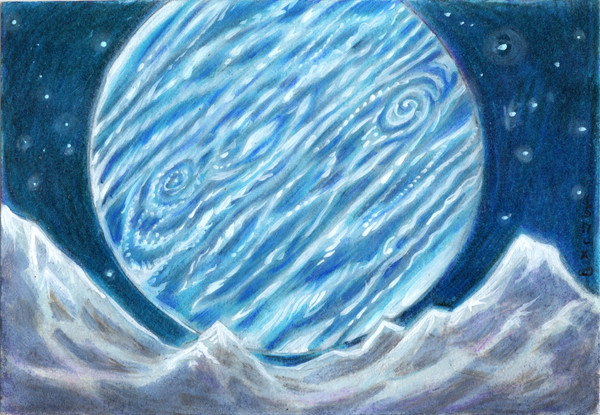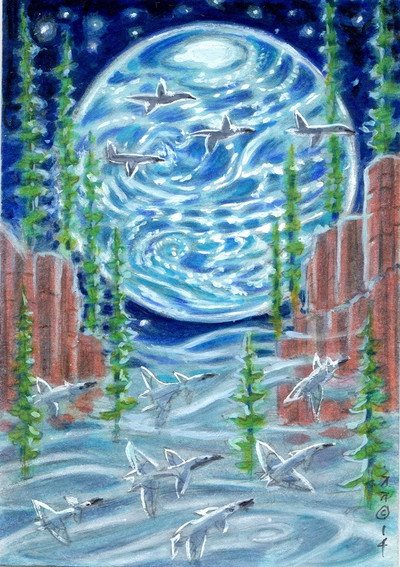HOME | DD
 LEXLOTHOR — Superearth in the Cold
LEXLOTHOR — Superearth in the Cold

#moons #planets #superearth #astronomy #exoplanet #spaceart
Published: 2015-11-18 21:26:54 +0000 UTC; Views: 934; Favourites: 17; Downloads: 7
Redirect to original
Description
More of my astronomical and space travel art can be seen in my DA "Space Art" gallery:lexlothor.deviantart.com/galle…
So-called "super earths" are a quandary. The discovery of rocky extrasolar planets many times more massive than our Earth has sent planetologists back to the blackboard.
One: They should have seen them coming. Just because there are no planets of this class in our own Solar System, doesn't mean that they shouldn't have been theoretically predicted half a century ago. Their existence should have been obvious.
Two: Now that they have found them astronomers are not thinking them through to logical extremes.
Massive rocky planets have been observed in many star systems. They may be capable of developing and sustaining CHON based life as we know it. However, they are looking in the wrong place for life sustaining superearths. Here is the dirty low down. Most superearths will be too hot to support life. Most of them should instead be considered Super Venuses. A planet five times the mass of the Earth is going to have a gravity well that will hang on to lots of primordial atmosphere. Depending upon the availability of certain elements in the protoplanetary disc that produce them, its atmosphere could be packed with rarer constituents such neon and argon. It will also be less likely to lose hydrogen due to disassociation from larger molecules caused by solar radiation. This is how Venus lost its oceans. A superearth is going to have crushing barometric pressure at its surface. When you compress a gas it gets hotter. Oceans wouldn't boil away because the triple point of water is raised to hundreds of degrees beyond 100 Celsius. Only extremophile microbes can survive under such conditions. Within the habitable zone of a star, a superearth would be heated to Venus-like levels where lead would melt at the surface. If you want to look for a superearth where creatures such as ourselves could survive at the surface you have to look OUTSIDE the Goldilocks Zone! If you wanted to have a habitable superearth in our own Solar System you would have to park it beyond the orbit of Mars!
Recent computer simulations have indicated that Mars should have accreted enough mass to become a superearth. The reason it did not is because Jupiter hijacked its potential mass supply out of the accretion disc during an earlier phase when it had an unstable orbit closer to the sun. This happened over four and a half billion years ago.
To get a habitable superearth, it has to be orbiting its star in a rather narrow band at which an equilibrium between incident solar radiation and intrinsic atmospheric heating occurs at the triple point of water at sea level.
There is another complication. Such a superearth is unlikely to have any exposed land at sea level. It would probably have global ocean hundreds of kilometers deep. In this case the ocean would be stratified into exotic forms of H2O unknown on the Earth or rare compounds such as ammonium anhydrate. The bottom of the water column would "freeze out" into forms of solid water that are hot ices such as ice-VII, X and XI. There may be hot superearths with oceans where water is maintained at moderate temperatures tens of kilometers below sea level. To have a superearth where the tolerable layer of water is near the surface.
I this illustration I depict a rare habitable superearth with a global ocean that is liquid at the surface. The top levels of this ocean abound with hydrocarbon life forms that replenish the atmosphere with oxygen and resupply the greenhouse gas methane. It is seen from the surface of its earth-sized moon that is a frozen ice ball.
As an interesting aside, a habitable superearth in orbit about a red dwarf might orbit far enough out that its rotation is not tidally locked with the star.
art & text (c) John P. Alexander
2.5" x 3.5" art card rendered in Prismacolor pencils, Tombow markers and acrylics.
Phase diagram of ices can be found in this Wikipedia entry:
en.wikipedia.org/wiki/Ice#/med…

























